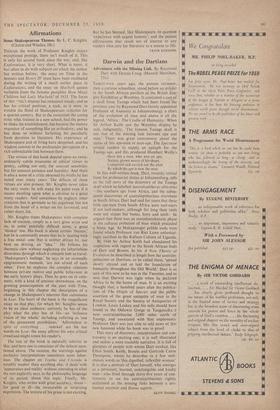Darwin and the Dartians
TIiarv-rive years ago, the present reviewer, then a curious schoolboy, stood before an exhibit in the South African pavilion of the British .g4Wi pire Exhibition at Wembley. It contained a cast of a skull from Taungs which had been founethe previous year by Raymond Dart (newly appointed Professor of Anatomy at Johannesburg), a chart of the evolution of man and above it all the legend, 'Africa : The Cradle of Humanity.' When Sir Arthur Keith saw the Wembley display he said, indignantly, 'The famous Taungs skull is not that of the missing link between ape and man.' There was great controversy about the status of this ape-man or man-ape. The Spectator invited readers to supply an epitaph for the Taungs ape, and this produced Humbert Wolfe's Here lies a man, who was an ape. Nature, grown weary of his shape. Conceived and carried out the plan By which the ape is now the man.
In this well-written book, Dart, recently retired from his professorial duties at Johannesburg, tells us the full story of the discovery of the Taungs skull which he labelled Australopithecus africanus —the southern ape from Africa, and the subse- quent discoveries of australopithecines elsewhere in South Africa. Dart had said for years that these little ape-men from South Africa were tool-users if not tool-makers, although for long their tools were not stones but bones, horn and teeth : he argued that there was an osteodontokeratic phase in the cultural evolution of man which preceded a Stone Age. At Makapansgat pebble tools were found which Professor van Riet Lowe unhesitat- ingly ascribed to the-Kafuan Culture of Uganda.
By 1948 Sir Arthur Keith had abandoned his scepticism with regard to the South African finds of Dart and Broom. In his A New Theory of Evolution he described at length how the australo- pithecines or Dartians, as he called them, 'spread slowly abroad and so laid the foundation of humanity throughout the Old World.' Dart is as sure of this now as he was in the Twenties, and as sure that Darwin was right when he declared Africa to be the home of man. It is an exciting thought that, a hundred years after the publica- tion of The Origin of Species and the public assertion of the great antiquity of man in the Royal Society and the Society of Antiquaries of London, Louis Leakey and his wife should have found in the Olduwai Gorge in Tanganyika. a newt australopithecine 2,000 miles north of Taungs, and associated with flint implements. Professor Dart was just able to add news of this new hominid while his book was in proof.
This story of discovery, interpretation and con- troversy is an exciting one; it is well illustrated and makes a most readable narrative. It is full of glimpses of people with whom Dart worked, like Elliot Smith, Keith, Broom and Gertrude Caton Thompson, whom he describes in a few well- chosen words as 'this dignified, inflexible woman.' It is also a portrait of Dart himself, who emerges as a persistent, learned, indefatigable and kindly man—who lived through thirty-five years of con- troversy to see his australopithecines rightly acclaimed as the missing links between a pre- human ancestor and Homo sapiens.
GLYN DANIEL


























 Previous page
Previous page